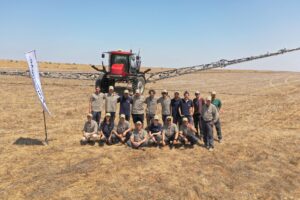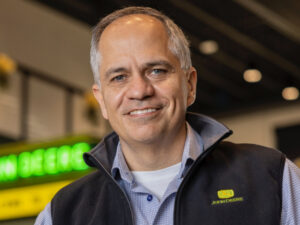Today BEE, a Mexican-American agricultural venture development firm, comes out of stealth to launch an end-to-end agriculture platform for emerging markets.
Landing in Mexico nearly eight years ago, cofounder and managing partner Everett Stephens had no idea where his journey to build a bioenergy project would take him. Keen to produce a sustainable source of food and fuel while bringing economic prosperity to parts of Mexico, he soon realized that a step-change was needed to bring Mexico’s agriculture industry into the 21st century, and that it would take more than planting energy crops and building a biofuel plant to get it there.
Mexico’s agriculture industry, like many others in the developing world, has a large number of smallholder, subsistence farmers. And faced with the challenges that a disconnected, disorganized, and segregated farming system brings, the Mexican farmers Stephens came across needed inputs, credit facilities, technology, end markets, and education on sustainable farming practices.
A complete reimagination of the farm and an evolution of the agricultural system are required to provide all of these things in a sustainable way that optimizes agricultural land, argues Stephens.
BEE is therefore building an end-to-end business to bring together farmland, technology, trading, and energy. The company has four units: BEE AG TECH, BEE ENERGY, BEE AG LAND, and BEE TRADING, and they are designed to work in concert with each other.
So what started as a project to produce a sustainable source of energy, has now become an infrastructure-scale initiative. But Stephens’ initial mission and values are still very much at the core of his work.
“My time fighting in the Gulf War at the age of 19 for the Marine Corps lit a fire in me,” Stephens tells AgFunderNews. “I think it’s absolutely absurd that humans should fight over natural resources; there has to be a better way to balance environmental stewardship, social improvements, and economics to truly benefit everyone. We’ve spent years in the fields working alongside the farmers and their national leadership to identify what it will take to truly improve productivity in these markets. This can’t be done from the comfort of Silicon Valley; it must be accomplished in a manner where environmental, social and economic benefits have equal footing.”
So how does it work?
Stephens started out in Mexico by mapping out the market, what existing infrastructure he could utilize, what the industry needed, and who he could hire to join him. This market mapping exercise resulted in the creation of a Mexican-American team.
“In order to be successful in Mexico, or any emerging market, it’s mission critical to first anchor yourself in the culture and customs of the country you serve,” says Stephens. “As such, we devote an extraordinary amount of time and resources to building our local teams and becoming a trusted part of the local and national communities. Showing up in emerging markets as a typical ‘American’ company is a tried and tested recipe for failure. So currently, we’re a US company that’s quintessentially Mexican.”
Soon after acquiring land to farm sugarcane on, BEE started looking for an agtech product to use to improve productivity and also to connect with the local industry. Failing to find a suitable solution, BEE is building its own software program to use as a CRM and ERP system, and this Agriculture Relationship Management (ARM) platform — a phrase Stephens has registered — underpins the whole end-to-end solution BEE wants to create.
BEE AG TECH, as the product is known, consists of this ARM platform — a system connecting farmers, suppliers, and offtakers to do business — and a precision agriculture offering to help farmers improve their yields.
After designing it, Stephens soon saw the need for an emerging market-specific agtech solution which none of the current options coming out of the US could provide.
“There is a strong disconnect between the promise of a lot of technology coming out of the US and how it’s deployed in emerging markets,” he says. “BEE, compared with agtech offerings designed from behind a desk in the US, has had boots on the ground for nearly a decade listening to the needs of the local farmers.”
The crux of BEE AG TECH is its ability to connect farmers with one another, and with their suppliers, to create virtual cooperatives and buying hubs. This collective purchasing power can help ensure they get access to the best fertilizers, seeds, and so on, at the best prices.
“We’re creating a scalable purchasing opportunity by providing access to inputs that emerging market farmers have not been able to achieve historically; a four hectare emerging market farmer is an island, if you can connect him to one thousand other farmers, suddenly you’ve got scalability and they have the same advantages that a large farming business would,” says Stephens.
This system is also integrated with BEE’s trading business, enabling farmers to purchase products through the system. It will also offer farmers credit facilities to purchase inputs on loan. BEE will make a fee on these transactions.
On the precision agriculture side, BEE AG TECH recently partnered with AgSmarts, a farm management platform. AgSmarts is headquartered in Memphis, Tennessee, and uses environmental-sensing technology, predictive analytics, and farm equipment automation to help farmers maximize crop yields, optimize water and energy use, and reduce operational expenses. AgSmarts is an AgFunder alumnus after raising $825k in convertible notes on the platform in 2014.
BEE came across AgSmarts when looking for an appropriate agtech product to use to help manage its sugarcane farmland operations. “After starting to build our CRM platform, we soon realized that AgSmarts was the other side of the equation,” says Stephens. BEE is currently raising $7 million to fully commercialize BEE AG TECH, according to Stephens.
The deployment of BEE AG TECH is another part of BEE’s secret sauce; it partners with existing wireless network providers to enable the large-scale deployment of the service, at infrastructure scale, and free for enrolled farmers.
Stephens expects a similar amount of infrastructural development will be necessary in other emerging markets, emphasizing the importance of making those early local connections.
“To be really impactful in emerging markets, you have to deploy technology at infrastructure scale; you can’t go door-to-door selling agtech, that won’t work,” says Stephens. “In three to four years, we want to be able to deploy precision agriculture at an infrastructural scale across entire emerging market countries so that it’s as easy as turning on the TV for farmers who decide to opt in.”
While BEE initially purchased and leased farmland in Mexico for its own sugarcane production initiative, it is facilitating investment in Mexican agriculture through its farmland platform BEE AG LAND. All farmland investments offered through BEE AG LAND will also connect to BEE AG TECH, providing investors with transparency and visibility over their investments. Stephens believes these digitized farms will provide investors twice the revenue of a US comparable.
Farmland investors will also have automatic offtake agreements with BEE. Producing bioenergy was Stephens’ first motivation in going to Mexico, and he intends to leverage this ag production model for renewable energy in other markets.
Thus, the whole system from farmland, inputs, improved production, energy, and trading come together, and it can be on a regional level or national level. It’s a big undertaking that we haven’t seen on this level before.
How does this look now?
In Mexico, BEE is currently growing sugarcane and sweet sorghum, acquiring additional production farmland, and has started to offer investments into both BEE AG LAND and BEE AG TECH. BEE ENERGY has all the essential contracts it needs to build a biofuel plant after becoming the first company in Mexico to receive a lifecycle analysis sponsored by Novozymes in Copenhagen to demonstrate ISO compliance. It has also secured a pay agreement with a guaranteed floor price for biofuels from BP and will aim to mimic this process in other emerging markets.
In order to pursue sustainable farming practices, BEE is also rotating those crops with food crops like soy, corn, and chillies. “For every hectare of energy crops we grow, we want to grow two hectares of food crops so that our lands can be sustainable, rotational, and feeding into the local food system,” Stephens says. “We’re building a high performance economic model in conjunction with a social and environmental model; we rank environmental stewardship on par with economic output.”
Stephens is proud of the reputation BEE has established in food and energy production circles, he tells AgFunderNews. BEE’s chief strategy officer Patrick McDonnell, for example, has been working closely with industry peers on the recently published report entitled Reconciling Food Security and Bioenergy: Priorities for Action. The report was coordinated by the Department of Energy’s Oak Ridge National Laboratory and was organized by the International Food Policy Research Institute, based in Washington, DC.
What’s next?
While BEE’s current focus is on Mexico, Stephens believes this model could be replicated across other emerging markets where smallholder farmers face similar challenges.
“The conditions needed to improve farmers lives and ag productivity are no different in Zimbabwe than they are in Haiti; the cultures are of course different, but fundamentally it’s about knowledge transfer and the chance to close the yield gap,” he says. “It’s no coincidence we’ve been invited to regions such as Africa to deploy BEE’s model of commercial farm production…And, we’ll be there in July.”
BEE will explore other emerging market countries including Peru, and the Philippines, and the next step will be the true test for how replicable the model is.
“We chose to start in the emerging markets because that’s where the absolute growth curve is for the foreseeable future and provides the best possible path to serve the largest number of people creating long-term ladders out of poverty,” says Stephens. “The regions we may avoid include those without any rule of law or policies and objectives that are not aligned with BEE’s business objectives.”
To pull this off, Stephens is assembling local teams in each country. For the Mexico project, he has hired Howard Reed, a Mexican agriculture leader as director of agriculture, Brian McNeill, a veteran natural resources investment manager, as chief investment officer, E. Craig Keohan, who steered HealthEquity to a $1.2 billion valuation and an IPO, will lead BEE’s shared services, Dr. Rafael Nieves is the director of science and technology for BEE after a 28 year career in renewable energy, and Dr. Julio Escandon, an expert in Mexican international trade negotiations, is director of trade and foreign policy. Strategy is lead by Patrick McDonnell, who has experience in rural economic development.
His investment partner Paul Harless, has worked with Stephens from the beginning. He is chairman of BEE and has worked in financial services for 26 years. He currently runs Just-In Time Entertainment, the management firm for his son, the entertainer Justin Timberlake.
The company is now starting to fundraise for each of the different business units. BEE currently has $8 million invested, and is seeking $7 million for BEE AG TECH and an additional $10 million for BEE AG LAND.
Have news or tips? Email [email protected].
















Sponsored
International Fresh Produce Association launches year 3 of its produce accelerator